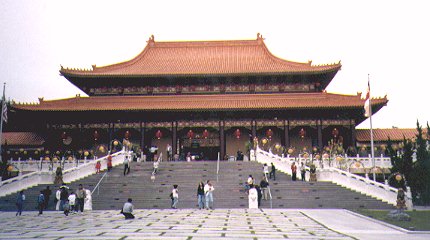
![]()
Re-accessing the role of temples in modern society
There are many Buddhist temple around the world that goes beyond the function of mere religious activities. The education value of Buddhism is strongly emphasized in most of the temples outside of Asia. Temples was traditionally functioned as a public space, that is to say they were an essential part of the community. Somehow or rather, today temples was in neglecting and hardly used to it's optimum purpose other than during festivals in Malaysia. This is partly because of the temple being a place for people to come rather than reaching out to the community. There is strongly a need to re-access the role of temple to search for it's role in modern society.

Case study from Hsi Lai Temple, California
Hsi-Lai temple is a large Buddhist monastery in California. Besides serving religious activities, the temple is further reinforced with educational facilities on Buddhism, and forms a community park inside the temple itself. The temple also have several gardens for cultivation and education.
Apart from that, inside the temple also serves as a museum where collection of Buddhist artifacts are being displayed. Furthermore, with a large community that supports the temple, a large convention hall was also built to hold Buddhism functions at a regular rate.
Case study from Ohtenin Temple, Osaka
Japanese Buddhism suffered a decline in modern society and hence most of temples in Osaka was revered as a temple of art. Upon entering, the building is more suggestive of a theater lobby than of a temple. There are tables and chairs set out for people to sit and drink coffee, and there are posters and leaflets on the walls advertising things like theater productions and films. The main temple is fitted with excellent lighting facilities and doubles as a theater. This is a temple of 'art.'
The
temple hosts a wide range of activities:
theater productions, seminars and Rakugo meetings, debates, NPO
(Non-Profit Organization) gatherings, film screenings, and modern art
exhibitions to educate buddhism in art through 'awareness, learning and
fun'.

The idea came as thru history temples took on the role as places for the implementation of social projects and services. Now, the move towards making room for art as well means providing space for 'fun' and 'enjoyment.'
"A temple is, after all, a sacred place. It is a place where people can take time to re-assess themselves."
--Akita, Chief Monk
"
In other words, this is a domain that stands at the opposite extreme from
urban theory, the theory that places importance on efficiency and
economizing. This reveals the significance behind re-establishing the
temple as a place of art. I think that the true nature of religion lies in
things which directly touch our soul. In modern society this spirit can be
seen in care-givers, teachers and artists," says Akita. I want the
temple to become a kind of infrastructure for the soul, transcending
religion and religious sects.In other words, Ohten'in is fulfilling the
role of temple."
--Akita, Chief Monk

Previous Next
![]() This
is a thesis website by ressox studio.
This
is a thesis website by ressox studio.

